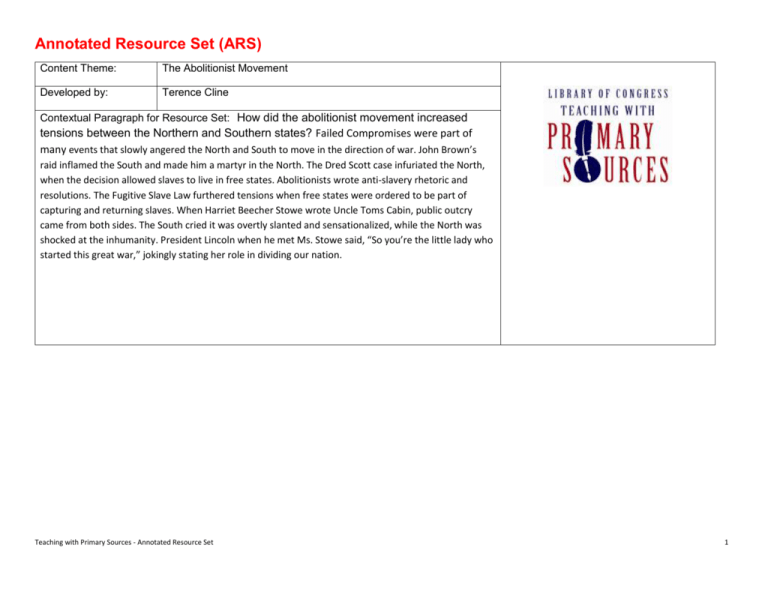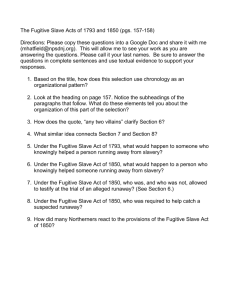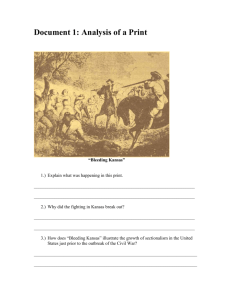Standard 9 Objective 1e.doc - Utah Teaching with Primary Sources
advertisement

Annotated Resource Set (ARS) Content Theme: The Abolitionist Movement Developed by: Terence Cline Contextual Paragraph for Resource Set: How did the abolitionist movement increased tensions between the Northern and Southern states? Failed Compromises were part of many events that slowly angered the North and South to move in the direction of war. John Brown’s raid inflamed the South and made him a martyr in the North. The Dred Scott case infuriated the North, when the decision allowed slaves to live in free states. Abolitionists wrote anti-slavery rhetoric and resolutions. The Fugitive Slave Law furthered tensions when free states were ordered to be part of capturing and returning slaves. When Harriet Beecher Stowe wrote Uncle Toms Cabin, public outcry came from both sides. The South cried it was overtly slanted and sensationalized, while the North was shocked at the inhumanity. President Lincoln when he met Ms. Stowe said, “So you’re the little lady who started this great war,” jokingly stating her role in dividing our nation. Teaching with Primary Sources - Annotated Resource Set 1 Resource Set Anti-Slavery Abolitionist resolution Fugitive Slave Act Fugitive Slave Act of 1850 Uncle Tom’s Cabin Full Text Satire on Uncle Tom’s Cabin John Brown http://www.loc.gov/pict ures/item/2004665375 http://www.loc.gov/rr/ print/list/picamer/paBr own.html Scenes of Anthony Burns Life http://memory.loc.gov/ rbc/rbnawsa/n1926/004 .tif http://loc.gov/pictures/resource/ cph.3g04550/ http://memory.loc.gov/am mem/today/jun05.html http://www.msa.md.gov/e cp/10/223/0001/html/000 10000.html Dred Scott Decision: http://www.loc.gov/pict ures/item/2002707034/ Notes/Comments: A dream – is a satire on Harriet Beecher Stowe’s anti-slavery novel Uncle Tom’s Cabin. Teaching with Primary Sources - Annotated Resource Set 2 Annotations Grade Level Curriculum Connections Curriculum Standards Learning Objectives Content Objectives 8 Novel: Uncle Tom’s Cabin US History I 9.1e Investigate how the abolitionist movement increased tensions between the Northern and Southern states; e.g., John Brown’s raid, Dred Scott Decision, Uncle Tom’s Cabin and The Fugitive Slave Law. Suggested Learning Strategies Thinking Objectives Assess how abolitionists felt about slavery Understand the impact of the Fugitive Slave Law, John Brown’s Raid and the Dred Scott case Decision. Determine the reaction caused by the writing and publishing of Uncle Tom’s Cabin Form an opinion from facts about the state/mood of the country before Lincoln’s election. Read the Anti-slavery Abolitionist resolution. Assess their resolve and roadblocks to ridding America of slavery using the Somebody-Wanted –But-So organizer. Determine a reaction to Uncle Tom’s Cabin by analyzing A Dream using the NARA cartoon analysis worksheet. Use the NARA poster analysis for analyzing Scenes of Anthony Burn’s Life. Ask: What did the Fugitive Slave Law mean to Anthony Burns? View the Fugitive Slave Act resource. Ask: Was he an isolated case? How do you know? What else might be going on? Use the NARA written analysis for Frank Leslie’s Illustrated: John Brown is a collection of documents. Tell students to treat this part of the assignment as if they were detectives. They are to piece together the story of his life and his impact on America. Suggested Assessment Strategies Formative Assessment: Create a list of abolitionist movements from the objectives. Instruct students to complete a quick write for each one. Links to Other Resources Nara: http://www.archives.gov/ education/lessons/index. html Summative Assessment: Students are to be an intelligence gatherer that will brief the administration of 1859 about the state of the country. To do this, create a 3 column chart. Column one is the event, column two is the Southern point of view of the event and column three is the Northern View. Ask: Do the events cause more anger and tension or less? What is your recommendation to the current president? Will war be likely? What are the facts? Report to the class on their findings. Teaching with Primary Sources - Annotated Resource Set 3 Teaching with Primary Sources - Annotated Resource Set 4 Teaching with Primary Sources - Annotated Resource Set 5 Teaching with Primary Sources - Annotated Resource Set 6 Teaching with Primary Sources - Annotated Resource Set 7







